I suppose most of us have had the experience of going to the mailbox and seeing that telltale package in the white plastic bag, the sign that something has just arrived from China. This happened to me the other day, and like many of you it was one of those times when I puzzled to myself: “I wonder what I bought this time?”
With so many weeks or months between the time of your impulsive click on the “Buy Now” button on AliExpress or eBay and the slow boat from China actually getting the package to your door, it’s easy enough to forget what exactly each package contains. And with the price of goods so low, the tendency to click and forget is all the easier. That’s not necessarily a good thing, but I like surprises as much as the next person, so I was happy to learn that I was now the owner of a tinySA spectrum analyzer. Time for a look at what this little thing can do.
First Impressions
A caveat: I’m by no means an expert on spectrum analyzers. In fact, this is the first time I’ve ever handled one, unless you count using the FFT functions in my digital oscilloscope, which you probably shouldn’t. So there’s probably plenty of room for operator error and misconceptions about what a spectrum analyzer can do in the tests that I ran, but I still think this is valuable as an example of what a tool like this can do in the hands of an enthusiastic newbie.
Anyone familiar with the NanoVNA, a small but full-featured vector network analyzer that we’ve featured a few times on these pages, will see a strong family resemblance between it and the tinySA, both in the hardware and the software. That’s for good reason — the code behind tinySA is a fork off the NanoVNA codebase, and the main developer of NanoVNA, edy555, is a contributor to the tinySA project, which is owned by Erik Kaashoek.
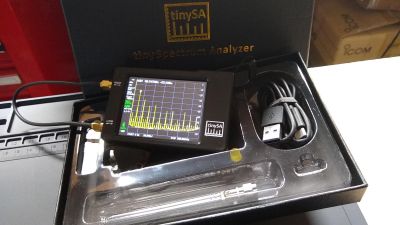 The tinySA arrived in a surprisingly nice “presentation quality” box with a gold-stamped logo on the top. Erik takes pains to note that this is one way to tell you’re getting an original tinySA as opposed to one of the inevitable knock-offs that’ll flood the market soon enough. I’m not sure that alone would keep the pirates at bay, but it’s at least an attempt and it’s a nice touch to boot.
The tinySA arrived in a surprisingly nice “presentation quality” box with a gold-stamped logo on the top. Erik takes pains to note that this is one way to tell you’re getting an original tinySA as opposed to one of the inevitable knock-offs that’ll flood the market soon enough. I’m not sure that alone would keep the pirates at bay, but it’s at least an attempt and it’s a nice touch to boot.
Along with the tinySA, which is about the size of a deck of playing cards, the box contains a pair of SMA jumper cables, a small telescoping whip antenna, a female-to-female SMA adapter, a wrist strap, and a USB-C cable. The case of the tinySA is injection molded ABS, and a nice upgrade in look and feel from the open board design of the NanoVNA. The front of the tinySA has no controls, just the 2.8″ 320×240 resistive touch-screen display. The top has a power switch and a jog control. The left side has two SMA jacks, labeled HIGH and LOW. It’s very lightweight but feels solid in the hand.
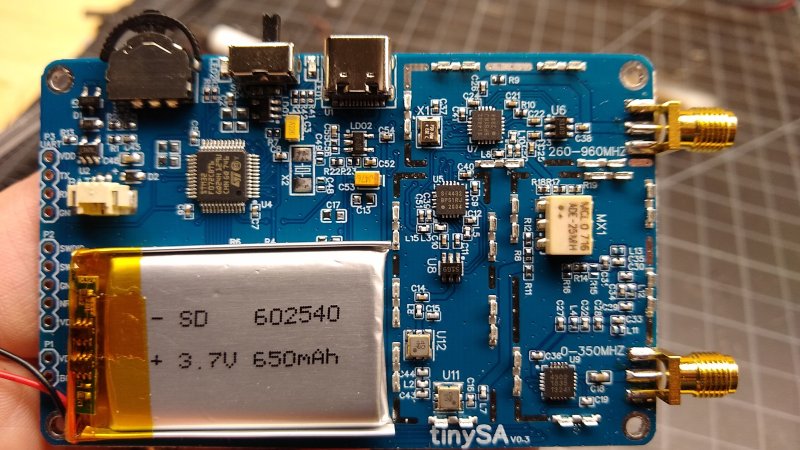
Of course the first thing I did was pop the case open and take a look inside. There’s not a lot to see at first — most of the interesting RF stuff is safely tucked under shielding. I figured I’d have to bust out the Hakko to take the tins off, but luckily they’re all spring-clipped to the ground plane, so removing them just took a small screwdriver. Underneath lay the expected RF wizardry, including the expected Silicon Labs chips. I found two Si4432 ISM transceiver chips, presumably one each for the high and low range of the tinySA. There’s also what appears to be a Peregrine Semiconductor PE4302 RF digital attenuator, and a bunch of other goodies. The layout is nice with plenty of via stitching, and the assembly quality is really good.
Satisfied with the insides, I moved on to the “First Steps” as listed in the video below, to get acquainted with the device. Erik has chosen to rely on the tinySA wiki and some how-to videos for most of the documentation, and while that’s understandable it also leaves a few holes that are up to the user to fill in. For those of us who prefer a real manual, Kurt Poulsen, a ham from Denmark, has written up a comprehensive how-to document that might be of help.
Anyone who has used a NanoVNA will feel at home in the tinySA interface. Calibration of the tinySA is done via the built-in signal generator, more on that below. Calibration itself is simple: hook the jumper coax between the two SMA jacks and select LEVEL CAL from the configuration menu. The calibration then proceeds automatically. The same menu offers a self-test function too, which cycles through a series of ten tests that take about 15 seconds to complete.
The Good Stuff
As for its primary purpose, the tinySA performed admirably in my limited tests. I took a look at the spectrum of signals generated by my scope’s built-in waveform generator and everything looked good — a 10-MHz sine wave appears as a single strong fundamental spike and one harmonic about 50 dBm lower. Switching the waveform to a square wave at the same frequency did what I thought it would — a big peak at the fundamental and a bunch of spurs at the odd fundamentals.

With the basics out of the way, I took a look at the tinySA’s built-in signal generator. As mentioned above, the signal generator is used for calibration, but it’s a pretty capable tool all on its own. It’s actually more of a function generator, since it can not only output a nice clean sine wave on the low output between 100 kHz and 350 MHz, but it can also modulate the signal (AM, narrow FM, and wide FM) and do sweeps both across a frequency range and over amplitude. On the high output, the signal generator does a square wave output from 240 MHz to 960 MHz with a configurable, non-sweepable amplitude, narrow FM or wide FM modulation, and a frequency sweep.
I gave the signal generator a go and took a look at its output with my Keysight DSOX1102G. The sine wave generated on the low output looked clean across the specified bandwidth, and the frequency was spot on. I tried playing with the modulation function, and it worked pretty much as I expected. It’ll be nice to have another signal generator around the shop.
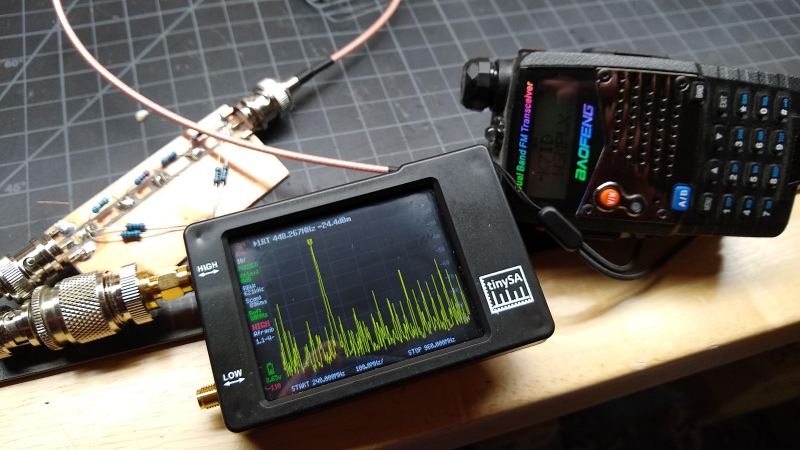
With all the pleasantries dispensed, I turned to the one task pretty much every ham will want to turn a spectrum analyzer on: finding out just how bad the signal from a cheap handy talkie is. I talked about this a bit in one of my $50 Ham articles, and we’ve seen comprehensive analyses of spurious emissions from these radios that are far more in-depth than anything I could come up with using the tinySA. But still, I thought I’d give it a whirl. I grabbed my Baofeng UV-5RA, a homebrew 40 dB attenuator I built a while back, and an unwieldy collection of adapters to connect everything together.
Being under the impression that the spurious emissions on Baofeng tend to be worse on the UHF band, I tried 420 MHz first. The first thing I noticed was that the fundamenal was off a bit from the where it should be. I also noticed a small forest of spurs starting at 500 MHz and extending all the way up past 800 MHz. The strongest spur was about 43 dBm down from the fundamental. The FCC rules on spurious emissions don’t seem to cover this band, but they do say that between 30 and 225 MHz, spurs need to be at least 40 dBm below the fundamental. So within the limits of my test setup, the Baofeng seems to just barely comply.
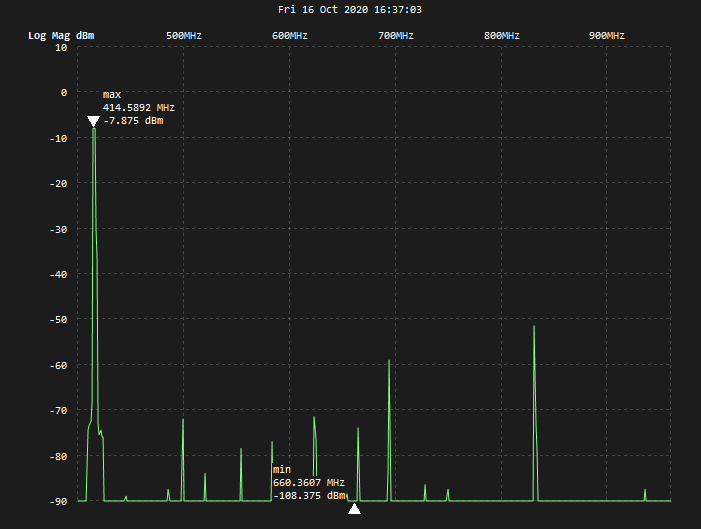
Just for completeness, I repeated the same test on the 2-m band. The signal was much cleaner here, with only a few spurs, the big one being at around 270 MHz. Again, this was about 43 dBm down from the fundamental, meaning it was probably in compliance. Again, this was only a rough test, with a test setup leaving much to be desired. But still, the tinySA is a nice way to take a look at what you’re actually putting out into the ether, and to at least get a rough idea how clean you’re operating.
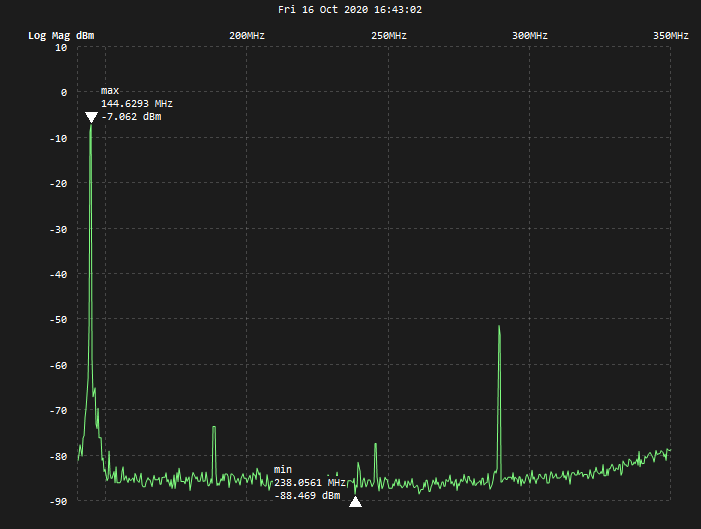
The Not-So-Good Stuff
Like the NanoVNA before it, the tinySA has the capability of PC control. The Python program, TinySASaver, is geared mostly toward saving scans from the tinySA, but also provides additional capability, like doing frequency sweeps in segments and exporting data for further analysis. It also implements time-domain reflectometry (TDR) to measure cable lengths and find faults. Sadly, try as I might I was unable to get TinySASaver running on my Ubuntu machine. Erik is pretty clear that the code is still rough, and I’m far from a Python guru so I might be having library problems that would be easy to fix for someone with more experience. Luckily, I was able to scrounge up a decrepit Windows laptop and get a compiled version of another program running, so I didn’t have to resort to cell phone pictures for my screenshots.
I have noticed a couple of other annoying issues. The biggest is that the tinySA appears to crash when you click the screen off of one of the menus. This is annoying, as I often found myself stuck in a menu with no obvious “Back” button, and clicking on the background seemed like an intuitive way to work back to another menu. But this just throws a dump of all the registers up on the screen and locks the thing up. It’s not a huge deal to recover — toggle the power and it’ll boot right back up — but it can be annoying. I also found the touchscreen a bit finicky, which was a common complaint with the NanoVNA. The screen is far too small for my meathooks, but without a proper stylus, I resorted to a plastic spudger that worked only most of the time. Of course it was only then that I looked in the box and noticed the wrist strap with the attached guitar pick-like stylus — a thoughtful accessory indeed.
Verdict
I’m not entirely sure what I paid for the tinySA — like I said, I tend to order these things and then just forget about them. But I think it was around $60, and at that price I’d say adding a tinySA to your toolkit is a no-brainer. It’ll never substitute for a larger, full-featured instrument, but if your only need for a spectrum analyzer is to design the occasional filter or check signal quality, the tinySA is a pretty good deal.

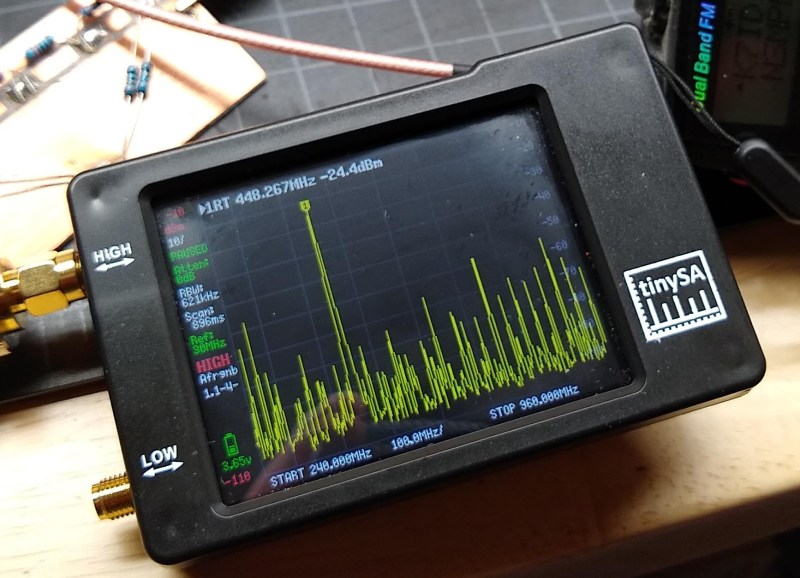













I noticed that the firmware on your unit is pretty old. The latest firmware is 1.1-24 and is located here: http://athome.kaashoek.com/tinySA/DFU/ there are a lot of new features regarding am demodulation and other things
Thanks, I thought I was probably a couple of revs behind. I’ll update as soon as I get a chance!
Sorry but china is producing good products. If not shure about quality don´t buy but stop
claiming they produce shit materials and products.
Heh, what exactly triggered you? I never noticed him talking about Chinese product quality. I did notice however that where Dan says “presentation quality” I was going “eeeek” looking at all that plastic packaging. Developed an allergy by opening too many micro SD cards I guess.
Nothing “triggered” me. But, I am very tired of comments about technology “made in china” or people who insinuate things are not good because of chinese production.
I took som examples: Xiomi phones, ZTE phones, branded chargers, Radio products like Baofeng, and the list continues.
Please don´t take me wrong.
Regards
China sells cheaper products. Those products are “cheap” and also “crappier” than more expensive products.
I own Baofeng radios, they’re shit, and yes it is because they’re made in China. I don’t have a use case for a good radio. That’s why I bought a Chinese radio.
Stop being triggered, it is the market position they’re trying to occupy. Stop trying to appropriate Chinese industrial policy. They want to sell cheap shit, they do sell cheap shit, they’re very happy selling cheap shit.
Nobody is taking you “wrong,” you’re taking honest words from people with free speech as if they are some sort of political statement that were crafted based on who is being talked about. But that’s not the case. You’re just triggered and making false accusations.
As for materials, Chinese steel DOES NOT have effective quality controls. Industries that need specific alloys often get a bait-and-switch when they buy Chinese steel. Chinese mild steel of course is what it says, and is cheap. This is well known. A Japanese steel company was in the news a couple years ago because they had resold a bunch of Chinese steel under their own labeling but they didn’t lab test it all and they got scammed on the later deliveries, oooops.
I’ve got a bunch of li-ion cells in view of me right now labelled things like “5200mAh” “9900mAh” etc. They’re all between 800mAh and 1400mAh, and they’re also from China. I also have a giant box of 2800mAh cells from Japan. Guess what? They’re 2800mAh. Because the Japanese company would get in trouble IN JAPAN for scamming me. The Chinese companies selling fraudulent products, OTOH, are government subsidized. Their nation therefore rightfully gets credit for having an industrial policy of selling cheap, mislabeled shit.
Maybe you have not noticed, but there isn’t much made in CN. I suppose you have an iPhone, right? Made in CN. You pay for a $50. Baofeng and get $100. worth of product direct from CN.
You buy an ICOM for $400. and get $200. worth of made in CN. Obviously, $200. is more than $50. so expect more. BUT it is all MADE IN CHINA. Please, don’t buy from CHINA, you may get an allergy. As for me, since everything is MADE IN CHINA why should I buy it in the US unless it isn’t available from CN or I need it tomorrow?
I have been buying parts from China for 20 years. One reason for this is their superior quality compared to western products, and this for only a fraction of the price.
Last year, there were 25 million more companies in China than there were in the US.
There are always companies who trick people. And this is true for China as well as it is for western countries. It’s a question of statistics: the more companies there are, the more bad ones there will be, even if the good/bad percentage stays the same.
So, there are more companies in China who will provide bad stuff, simply because there are many more companies there. With this in mind, one has to be very careful with doing business with companies over there. The companies have to be carefully verified first. Only after trust is established and verifications have been achieved successfully can business interactions begin.
There is an awful lot of good companies in China. But it’s the few bad ones who give a bad reputation to all the rest. I did have bad experiences with some companies in China. But after learning how to establish if a company can be trusted or not, I now have excellent parts for a very low price.
Their industry is highly mechanized, and technologically at the top. They produce in huge quantities and have low prices. Still, as I mentioned, their quality is higher and higher.
Another point to their advantage is that all the related industries are close together. There are no
transportation costs. Companies making transformers are close to companies making copper wires…
The dark side lies on how they treat their employees. But this seems to be changing with the years.
There are many different fields in business. The industrial field is not the same as consumer
field and a good proportion of the “bad” companies are precisely in the consumer field. although there is a great difference now compared to a few years ago: It’s getting better over the years.
Several good quality products come out of China (Bose for example), but many more products come out of China that are absolutely shit. Some with real branding, some with counterfeit branding, and some they don’t even put a brand on because it would cost too much in ink!
A race to the bottom doesn’t even come close to describing most Chinese products. Buyer beware.
I don’t think Erik is a Chinese name… :) If you don’t want it made in China offer him a better deal. The way it is it’s the best 50 bucks I’ve ever spent (and I own high end HP gear as well).
The newer FW also solves the crash you have seen
Well, I give that battery about a year…
“I wonder what I bought this time?”
I stopped doing that.
Christmas every day!
https://dilbert.com/strip/2021-03-25
The wondering or the buying?
IMSAI Guy has a LONG series on youTube covering the TinySA, the good, the bad, and the ugly. Well worth the watch if you want to know about the device, see it compared to some heavy iron on the bench, see how and why it is used, and get a fel for the good, the bad, and the ugly.
His videos focus a lot on observing AM modulated signals. The tinySA initially was not optimized to handle this. The latest firmware has added optimizations for these signals
The latest firmware adds an optimization for observing AM modulated signals
IMSAI Guy TinySA YouTube video playlist (there are lots of them):
https://www.youtube.com/watch?v=n6WEM3–Npc&list=PLXDK0MeyK4ZgnYyh1INCSv_lhteEs4Tkt
And just for fun here is the IMSAI Guy NanoVNA YouTube video playlist:
https://www.youtube.com/watch?v=Xq86EMniXhM&list=PLXDK0MeyK4ZhPjgg6xkBzt6OVtc5leUgA
The tinySA designer, Erik, has a series of videos on the device, too:
https://www.youtube.com/user/superduramen/videos
The IMSAI Guy series is useful, but the more knowledgeable have noticed that he sometimes gives wrong information, so don’t take everything there as gospel. Other than the occasional misinformation, it’s overall a pretty decent set of videos.
I have 3 tinySAs, and might get another to keep in the car. I also have some pro gear, but this thing has a LOT of functionality, and is much more convenient to carry around. The tinySA has features that my “big” SA doesn’t have, although some of them can be added – for a price. Erik has done a great job of squeezing an amazing set of features out of simple hardware.
Beyond any doubt in my mind, you are radiating (and possibly reflecting) significant energy with that pictured attenuator – which could affect measurements in a myriad of ways. I say this because I’ve made similar looking devices. I’d like to hear what others have to say in regards to this assertion, or why I might be incorrect.
It looks awesome for the price, but, the main thing I want an SA for is to look at sources that are emitting noise, and ambient noise. The more expensive GQ electronics version also has magnetic and electric field data, which makes it far more interesting to me.
I do also carry a NanoVNA because of it’s LCR metering and time domain reflectometry for cable faults, but I might give this one a pass since I’m not a serious RF expert.
An appeal to manufacturers: I understand that 2-3″ screens are among the cheapest around, but please don’t forget about people with less than perfect eyesight. Mine isn’t that bad, but the NanoVNA to me without magnifying glasses is next to unreadable, and this one wouldn’t change much, although I’ll probably order one anyway just to support the project.
However, I would happily pay 20-30 more bucks just to have a 7″ screen.
Same here.
I’m curious then, would I be better off with this or with a nano VNA as a first purchase?
I have both. Each has its own niche.
It really depends on what you want to use them for.
I have a nanoVNA and a large desktop spectrum analyzer.
But if you want to do EMC pre-compliance probing and stuff like that, I’d take the tinySA over nanoVNA for that job.
If I want to check cables and antennas, I’d take the nanoVNA.
Right tool for the right job and all that.
[sigh] if only there was a way to recycle my old Samsung Tab S2.
At about 8 inches, or roughly the size of a paperback novel, it was much easier to read than the screens on these little things.
My thoughts exactly, only I have an old Nexus 7. Just an android app and an OTG cable away from reality. I’m sure someone will convert the windows version of the remote control software that comes with the device at some point.
Many products made in China use components with dubious specifications or are outright counterfeits. The PCBs can be very poor quality, lacking impedance control and proper shielding of RF sections.
A few products with direct supervision and onsite QA are built to higher standards. Unfortunately, the NanoVNA copies and the copies of the TinySA fall into the poor quality realm. To call these copies precision instruments is quite laughable. However, they may be useful for very casual measurements, fooling people who have no idea how to validate the results they see on the display. Because, of course, if a device shows you something, it must be precisely correct, right?
The ‘original’ versions of the NanoVNA, NanoVNA2 and the TinySA are of much better quality (but still not ‘lab quality’) than what we will see from resellers in a few months. Chinese disregard of IP laws and their blatant lowest cost production standards cause poor quality copies that tarnish these brands and I urge everyone to make sure you only buy the genuine articles, both to be sure you get what you pay for, but also to support the original designers of the ‘real’ products.
I’d submit that if these designer built these units in the US, Germany or Japan and sold them for 2x the China price, they would have a lot more happy customers who would actually could rely on the products they bought.
Why would it be lab quality? Its a $60 piece of equipment. why do people always want Ferrari performance from a Volkswagon beetle? Get real people.
Is there a chance this could be used as a oscilloscope (with modified SW)?
Gregor said: “Is there a chance this could be used as a oscilloscope (with modified SW)?”
You should not need any “modified” software to use a real spectrum analyzer in the time domain. You can put a spectrum analyzer into “zero span” mode with the power detector in linear mode (not logarithmic mode) and then adjust the trigger, sweep time, vertical position, and video bandwidth until you get a stable and meaningful time domain display. Now you are using a spectrum analyzer as a “kind of” time domain oscilloscope. But there are two big differences: 1. Your “oscilloscope” is measuring power, not voltage like a real oscilloscope. 2. Your “oscilloscope” has a very low input impedance, typically 50 Ohms. This low input impedance may load down (and possibly damage) the circuit you are trying to measure.
Nevertheless, this turning a spectrum analyzer into a oscilloscope is very useful if you want to see the modulation time domain waveform of an RF signal, especially when the RF signal is at a frequency much higher than what your normal oscilloscope is capable of measuring.
I do not own a TinySA so I can not say if it has the modes necessary to allow it to be used as a zero span time domain analyzer. But all the “real” spectrum analyzers I’ve used are designed to allow time domain measurements.
Here is a short but informative video on this “Zero Span” subject by W1AEW:
#47: Basics of Zero-Span operation of a Spectrum Analyzer
https://www.youtube.com/watch?v=Lp6sT-n55N4
https://www.youtube.com/watch?v=Lp6sT-n55N4
tinySA has a fast zero span mode allowing to see audio modulation in AM. Or you can set a specific sweep time to monitor slower changes.
See this video: https://youtu.be/VDhER1WxN6k?t=244
@Dan Maloney: If your Baofeng was barely in-spec with at the 2nd order product, you are very likely to be waaay out of spec at the 3rd order frequency. But unfortunately the TinySA doesn’t go high enough in frequency to let you see the 3rd order products of a 70cm UHF transmitter.
When you were measuring the Baofeng spurs did you have the transmit power in High or Low power mode? There is a good chance that if you are operating on High power and the 2nd order product is barely in-spec, then when you switch to Low power I’ll bet you will see the carrier power drop but the 2nd order product amplitude will not change much. The result is that you end up being waaay out of spec again but at the Low power setting. This indicates to me that the 2nd order signal is not so much a harmonic product due to inadequate filtering and/or transmit nonlinearities but more so a harmonically related unwanted spurious emission, perhaps from the synthesizer. This is what I saw with a Baofeng UV-82 radio on an HP8591E spectrum analyzer.
Nice to see proof that the Baofengs aren’t as bad as crudgedly old HAMS want to believe
china can deliver a product for any market, you want cheap? they can deliver cheap, you want middle of the road, they can do that too, you want top quality? oh yes they can deliver with the best.
if you think they as a people are inferior to western people in production capability, you would be sadly wrong. if you think they can’t built top quality production facilities, again you would be sadly mistaken.
to simply blather on about china building shit, is to sit back and find out they have passed you by.
i am old enough to remember that japanese manufactured stuff was crap! and we all made a joke of it, all the while they kept their heads down and improved… while we kept on building crap cars and all manner of other stuff, because we could get away with it… then one day we found out that “hey those honda car’s run like forever, and my gm/ford/chrysler cars barely run to 100k (and in many cases far less)”
we woke up in the late 70’s way behind what we once thought of as a producer of crap! and took us a long time to catch up again. that is if we actually did catch up, and that is arguable.
as this relates to the tinysa? again i am old enough to remember being in tech school in the early 70’s and we only had one spectrum analyzer in the class, and no one was allowed to use it that i know of, because they were bloody expensive.
does the tinysa have the ability to compete with a 10k dollar (or more) spectrum analyzer? no, but… it gets close enough for a lot of people, especially if you really try to learn how to work with and around its shortcomings.
hell i could never afford an hp or other lab quality spectrum analyzers, but i can surely afford a tinysa! and for the 64 bucks delivered it is probably the best 64 bucks i have ever spent on a piece of test equipment!
and from what i have learned so far watching folks put the tinysa up against lab quality spectrum analyzers, the tinysa is good enough for the girls i run with!
i suspect in the next 10 years there will be more coming from china that will change a lot of minds, even those that are reticent of change will have to admit they have passed us up… that is unless we take the challenge seriously now!
I have extensive experience with China, both as a project manager on petrochemical projects and equipment supply. Chinese Products can be good or bad. The main issue is quality control, there are many US companies that manufacture things in China and the only way to insure you are getting what you specified is to have your own QA/QC people on site.
Someone mentioned steel in a previous post. I worked with a company that purchased 6 very large drilling rigs from a Chinese supplier. When the rigs arrived in the US they were sent to a yard in Texas to install additional equip. The dropped a stand of drill pipe and it hit a crossmember. The results were not pretty. When the steel was check in a lab it wasn’t even good enough to be used as rebar. There was documentation on all of the steel and it was all stamped stating that the steel was all checked and passed. All of the paper was fictitious. The Chinese company was sued in Chinese courts and they found that the cheating was so blatant that they awarded the US company damages.
The moral of the story is that the products from China are only as good as the Quality inspectors. It is always best to talk to other people who have purchased the product for their reviews.